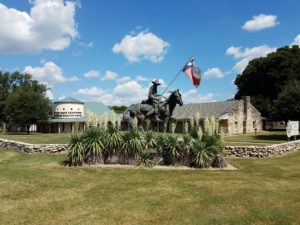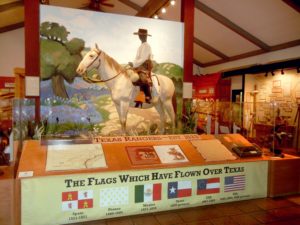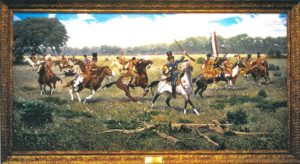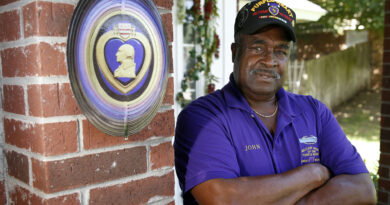Living history at the Texas Ranger Hall of Fame and Museum in Waco
By Catherine Hosman
Photos courtesy of the museum

The moment you step into the rotunda entrance of the Texas Ranger Hall of Fame and Museum you are immersed in a time when four factions of humanity came together in the fight to settle Texas: Mexicans, Native Americans, settlers and the newly formed group of men who would come to be known as the Texas Rangers.
The first thing that captures your attention is the Homer Garrison exhibit that depicts an early ranger on horseback dressed in period clothing (in the early days, rangers were also land surveyors). In front of the ranger is a showcase that displays artifacts and a map of Tejas, Mexico, illustrating the range of Native American tribes that were spread over the territory.
From the westernmost frontier to the eastern border and from north to south, Tejas was home to many Native American tribes including the Apache, Lipan Apache, Tonkawa, and Karankawa on the Gulf Coast. But none were as feared as the Comanche, who called 250,000 square miles of the territory home.
“The Homer Garrison exhibit was the entire museum when it first opened (in the 1960s),” said Christine Rothenbush, marketing, communications and development specialist.

It takes about three hours to go through the entire museum, including the 45-minute film that introduces the history of the Texas Rangers and their role in taming the Texas frontier. It takes longer for those who like to read all of the narrative cards on the displays.
The Museum pays homage to the men who served as Texas Rangers from 1823 through today. (Today’s Texas Rangers include men and women and serve under the Texas Department of Public Safety.)
In 1821 Mexico won its independence from Spain. The government decided to open up the Tejas territory to settlers from the United States and Europe in order to create a buffer between themselves and marauding Indians defending their homeland and lifestyle from the Mexicans.
The Mexican Government named Moses Austin as empresario. He was authorized to bring settlers into Mexican territory with the promise of land if they agreed to become naturalized Mexicans, adopt Catholicism and learn Spanish. When Moses died from pneumonia at the age of 59, his son Stephen F. Austin took over his commission.
American and European immigrants moved into Tejas territory between 1821 and 1829. In 1823 the Mexican government was dealing with political and economic turmoil following their independence and was unable to protect its northern territories from attack by Indians.
“The pressure of Indian raids, two companies of “men . . . to act as rangers for the common defense,” were formed under Stephen F. Austin’s authority as empresario. These men are commonly regarded as the first Texas Rangers,” according to the museum’s website.
The exhibits

Expect some sensory overload as you view 20th Century western paintings and sculptures that line the halls and walls of the museum.
Thousands of artifacts are respectfully displayed in glass cases. Weapons dating to the 1700s include a Kentucky long rifle, a plains rifle, powder flasks, a derringer pistol, flintlock pistol, ivory powder horns, carved ivory gun and rifle handles — all intricate works of art. There are also the hand-tooled leather saddles, belts, and holsters that once belonged to a Ranger. Other displays include early surveying equipment, a collection of spurs, ropes, boots, clothing,
Native American artifacts and so much more. In one hall you can hold a colt repeating pistol. Brace yourself, it weighs nearly five pounds.
Rothenbush said it’s fun when she sees people pick up one of the guns for the first time and realize how heavy it is.
“You see that look on their face as they go ‘whoa,’” she said. “We are creating more things people can do that are hands on. They can learn through doing and not just seeing objects.”
One exhibit room is dedicated to the Texas Rangers of film, television and culture. Movie posters line the walls and childhood memories are relived in the form of lunch boxes, games, cups, girls’ purses and comic books that depict the “Lone Ranger.” You can even take your photo, in costume, with a life-sized cutout of the Lone Ranger and Tonto and see one of the masks said to have been worn by Clayton Moore in his role as the masked crusader.
More current is a showcase of the “Walker, Texas Ranger” television series. Chuck Norris portrayed modern-day Texas Ranger Cordell Walker. Neatly displayed behind glass is a shirt, hat, jacket, and gun belt worn by Norris and a signed script from one of the shows.
The museum has evolved since it first opened in the 1960s and Rothenbush said new artifacts are arriving all the time.
“We are doing a lot of changing of exhibits. We are doing a lot more programming, bringing in history presentations, speakers and children’s events since I’ve been here,” said Rothenbush, who started with the museum in 2007.

This 4’10″x 8’10″ (framed) image depicts a band of Penateka Comanche mounted on horses and dressed in full battle regalia at the 1840 Battle of Plum Creek, which occurred on Aug. 12 near present Lockhart, Texas.
On loan by William Adams
One of the biggest differences people will find at the Texas Ranger Hall of Fame and Museum compared to a Civil War museum, Rothenbush said, is that all the Union and Confederate soldiers are gone.
“The Texas Rangers still exist, still making history,” she said. “As long as they do that we will be here recording it.”
If you go
Texas Ranger Hall of Fame and Museum
100 Texas Ranger Trail, Waco, TX 76706
From I-35 take Exit 335B toward University Parks Dr/Ferrell Center/Farm to Market Rd 434/Baylor University.
Hours: 9 a.m. to 5 p.m. Sunday to Saturday (last guest admitted at 4:30 p.m.); Closed for Thanksgiving, Christmas and New Year’s.
Gift shop: 9 a.m. to 4:30 p.m.
Cost: $8 adults, $7 seniors, $7 military with ID, $4 kids (6-12), Children under 6 are free. Free parking except during Baylor football games; parking is reserved for Baylor Club members.
Call 254-750-8631 or visit www.texasranger.org for more information.




